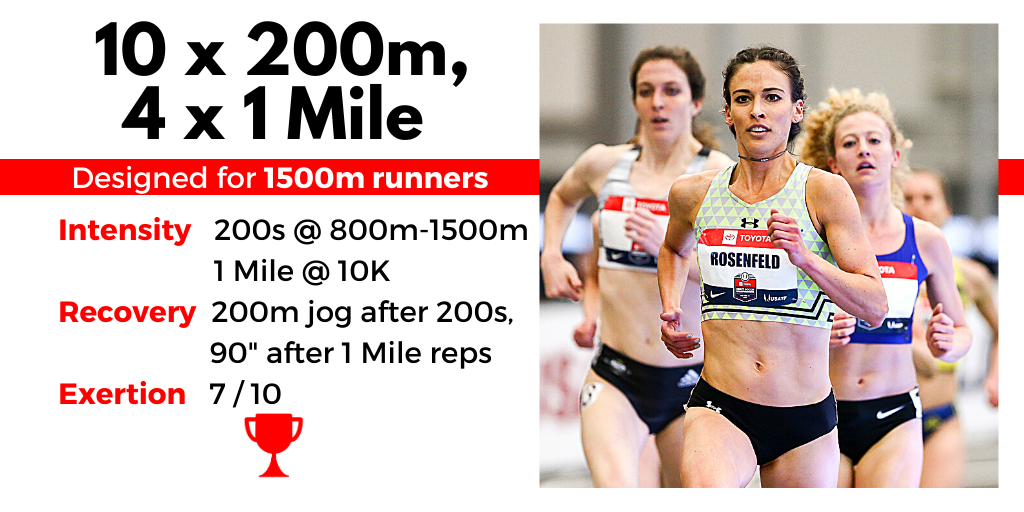10 x 200m, 4 x 1 Mile
10 x 200m, 4 x 1 Mile
Designed for 1500m runners
Intensity
200s @ 800m - 400m pace
1 Mile reps @ 10K pace
Recovery
200m jog as needed between 200m reps
1 Mile easy jogging between sets
90 seconds between 1 Mile reps
Exertion
7/10
Periodization
Specific Period, Introduction Block
Context & Details
Not every workout in the runner’s training diet needs to highly difficult. In fact, as a runner progresses in their training year, workouts become increasingly maintenance in nature.
Maintenance workouts are important to retain hard-earned improvements to fitness and biomotor qualities but are often overlooked or neglected.
Zatsiorsky, in Science and Practice of Strength Training, classifies training load into 3 different types according to their magnitude:
Stimulating — where the magnitude of load is above the current fitness level of the athlete.
Retaining — where the magnitude of load is in line with the current fitness level of the athlete.
Detaining — where the magnitude of load leads to a decline in performance results, functional capacities of the athlete, or both.
Retraining or maintenance loads are relative to the athlete’s current condition. A load that was once stimulating early in their training can become retaining in later stages — which is the case with today’s workout.
For a runner, the Specific Period of training is the most difficult. Typically, for even the fittest runners, there will be 2 main workouts, both highly difficult, in a training week. Those sessions are designed to provide the race-specific stimuli needed to upgrade their performance ability. This leaves much training week spent recovering from the most recent difficult session and preparing for the next.
It would be a mistake to only easy jog or bed rest for the 5 non-workout days, as significant detraining effects would occur and the runner wouldn’t improve much from those two hard efforts.
Enter today’s workout.
The design of this session is meant to retain the most transient and neglected fitness qualities. For any runner, the most transient quality is Speed and for a miler in the Specific Period, the most neglected quality is usually Aerobic Capacity.
For runners, a significant decline in speed can happen with 3 - 8 days of neglect — and is one reason why speed is a skill that is wise to rehearse year-round.
Additionally, the Foundation Period for miler is typically marked by a heavy dose of Aerobic Capacity improvement work. In the Specific Period, the aim is to translate that elevated Aerobic Capacity into Aerobic Power, so the focus of the main workouts will shift to Aerobic Power — leaving Aerobic Capacity neglected. This quality is not as transient as speed, as it takes 30-40 days of neglect to see a substantial decline.
However, I think it’s smart to practice minimizing the decline in Aerobic Capacity during the Specific Period so the runner can sustain more volume of intense work resulting in better upgrades in key performance variables.
To accomplish all of this is very simple: have the runner perform a manageable, non-fatiguing, load of speed work followed by Aerobic Capacity work in a training session.
I opt for this training session to happen in the middle of the week. If a runner has a Monday/Wednesday/Friday workout training rhythm. The harder race-specific sessions will be Mondays and Fridays and the maintenance session will be on Wednesdays.
Because the training loads are designed to be non-fatiguing, a maintenance session acts as a higher grade active recovery.
The volumes reflected in this session are for a season adult runner.
For younger milers, the coach can adjust this session to 800m - 1600m worth of 800m-400m speed work as 100m to 200m and 1 - 2 miles of Aerobic Capacity packaged as 600m to 1K reps.
Continue Learning
Join the Scholar Program for $29 to learn more about successful 1500m Training and get unlimited access to courses and training programs on middle-distance running.
Good books on 1500m training
Better Training for Distance Runners by Peter Coe
Winning Running by Peter Coe
Running Science by Own Anderson
Modern Training and Physiology for Middle and Long-Distance Runners by John Davis

